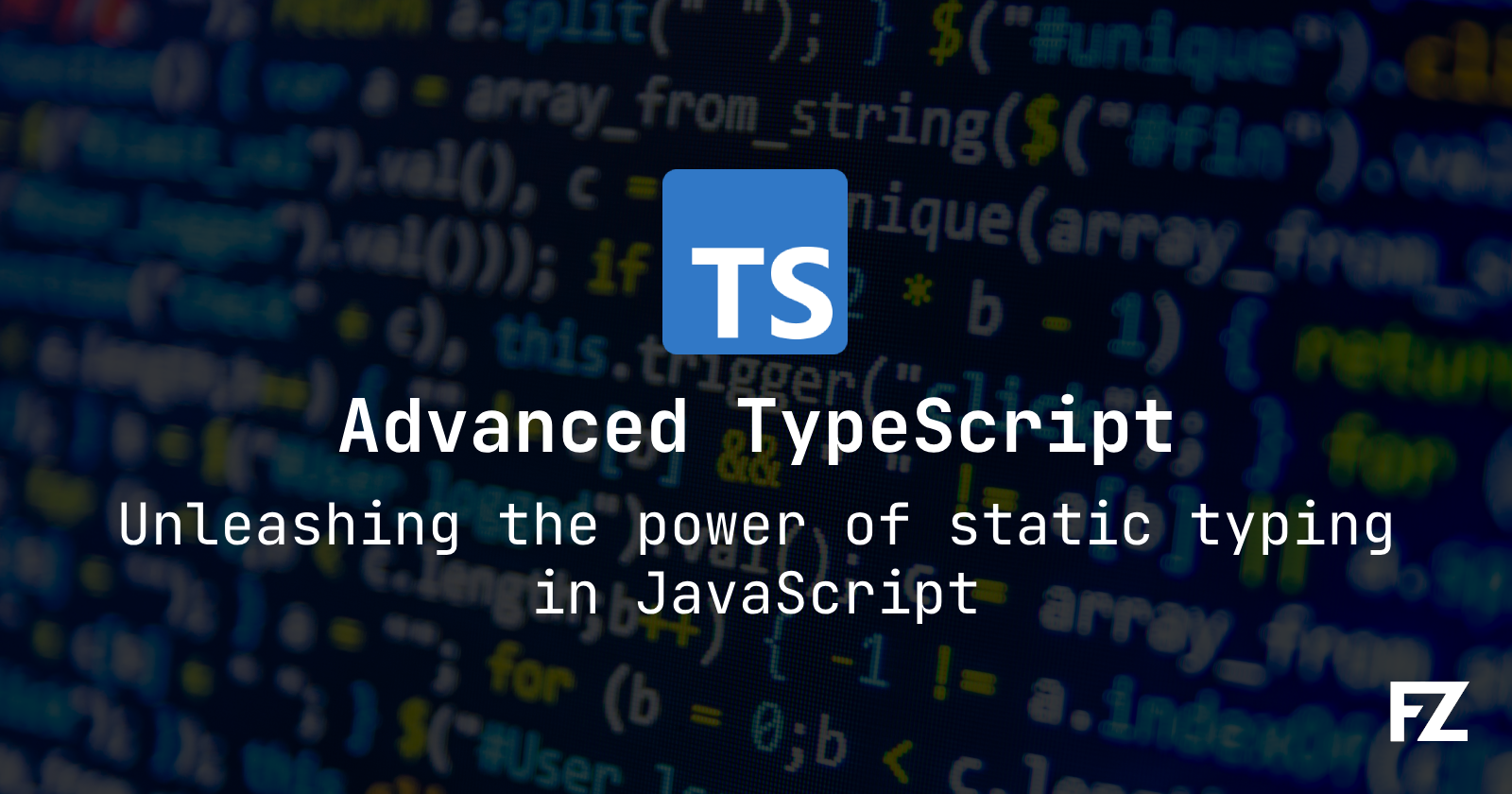Advanced TypeScript: Unleashing the Power of Static Typing in JavaScript
 Ares
Ares
While TypeScript includes all JavaScript features, it also introduces several advanced features that set it apart and make it a compelling choice for complex projects.
In this article, we will dive deep into some of these advanced features of TypeScript, including Union Types, Intersection Types, Type Guards, Mapped Types, Generics, Decorators, Advanced Compiler Options, Namespaces and Modules, Mixins, and Declaration Merging. These features not only enhance the robustness of your code but also make it more maintainable and scalable.
Some Advanced Types in TypeScript:
Union Types and Intersection Types: Union types are a way of declaring a type that could be one of many types. For example,
let id: number | string;Here,idcan be either a number or a string. This is particularly useful when you don’t know what type a variable could be.Intersection types are a way of combining multiple types into one. This allows you to add together existing types to get a single type that has all the features you need. For example,
let mixedType: Type1 & Type2;Here,mixedTypewill have all the properties and methods ofType1andType2.Type Guards: Type guards allow you to narrow down the type of an object within a certain scope. This is done by performing some kind of check in an if statement. For example, if you have a variable that is a union type
number | string, you can use a type guard to check if the variable is a number before performing number-specific operations on it:if (typeof variable === 'number') { // In this block, variable is treated as a number console.log(variable.toFixed(2)); }Mapped Types: Mapped types allow you to create new types based on old ones by mapping over property types. For example, you can create a new type that makes all properties in an existing type optional:
type Partial<T> = { [P in keyof T]?: T[P]; };Here,
Partial<T>is a new type that has all the properties ofT, but every property is optional. This is actually how the built-inPartialtype in TypeScript is implemented.
Generics in TypeScript:
Generic Constraints: In TypeScript, you can use generic constraints to allow a certain operation on a generic parameter. For example, if you want to access a property
.lengthonT, you can constrainTto types that have.length:function loggingIdentity<T extends { length: number }>(arg: T): T { console.log(arg.length); // Now we know it has a .length property, so no more error return arg; }Using Type Parameters in Generic Constraints: You can declare a type parameter that is constrained by another type parameter. For example:
function getProperty<T, K extends keyof T>(obj: T, key: K) { return obj[key]; } let x = { a: 1, b: 2, c: 3, d: 4 }; getProperty(x, "a"); // okay getProperty(x, "m"); // error: Argument of type 'm' isn't assignable to 'a' | 'b' | 'c' | 'd'.Generic Classes and Interfaces: Generics can also be used in classes and interfaces. A generic class has a similar shape to a generic interface. Generic interfaces can act as function types:
interface GenericIdentityFn<T> { (arg: T): T; } function identity<T>(arg: T): T { return arg; } let myIdentity: GenericIdentityFn<number> = identity;
In the above example, we’ve made our interface generic. Then, we used the interface in the function signature to indicate that it’s a generic function.
Decorators in TypeScript:
Class Decorators: A Class Decorator is declared just before a class declaration. The class decorator is applied to the constructor of the class and can be used to observe, modify, or replace a class definition. A class decorator cannot be used in a declaration file, or in any other ambient context.
function sealed(constructor: Function) { Object.seal(constructor); Object.seal(constructor.prototype); } @sealed class Greeter { greeting: string; constructor(message: string) { this.greeting = message; } greet() { return "Hello, " + this.greeting; } }Method Decorators: A Method Decorator is declared just before a method declaration. The decorator is applied to the Property Descriptor for the method and can be used to observe, modify, or replace a method definition.
function enumerable(value: boolean) { return function (target: any, propertyKey: string, descriptor: PropertyDescriptor) { descriptor.enumerable = value; }; } class Greeter { greeting: string; constructor(message: string) { this.greeting = message; } @enumerable(false) greet() { return "Hello, " + this.greeting; } }Accessor Decorators: An Accessor Decorator is declared just before an accessor declaration. The accessor decorator is applied to the Property Descriptor for the accessor and can be used to observe, modify, or replace an accessor’s definitions.
Property Decorators: A Property Decorator is declared just before a property declaration. A property decorator cannot be used in a declaration file, on a parameter, or in any other ambient context.
Parameter Decorators: A Parameter Decorator is declared just before a parameter declaration. The parameter decorator is applied to the function for a class constructor or method declaration.
Remember that decorators are a very powerful feature of TypeScript, but they should be used wisely due to their high level of abstraction.
Advanced Compiler Options:
strictNullChecks: This is a compiler option that enforces strict null checking. When this option is enabled,
nullandundefinedvalues are not assignable to any type other than their own andany. This helps avoid common bugs that stem from trying to access properties onnullorundefinedvalues.let s = "hello"; s = null; // Error when strictNullChecks is enablednoImplicitAny: This option raises an error when the TypeScript compiler cannot infer the type of a variable. If you do not specify a type and the compiler cannot infer it from context, it will normally default to
any. WithnoImplicitAnyenabled, this will raise a compile error, forcing you to explicitly declare the variable’s type.function log(arg) { // Error when noImplicitAny is enabled console.log(arg); }noUnusedLocals: This option ensures that you do not have any unused variables in your code. When this option is enabled, the compiler will raise an error if you declare a variable but never use it. This helps keep your code clean and avoids unnecessary memory usage.
let x = 10; // Error when noUnusedLocals is enabled
These options can be set in your tsconfig.json file under the "compilerOptions" property. They help enforce stricter type-checking and cleaner code, making your TypeScript code more robust and maintainable.
Namespaces and Modules:
Namespaces: Namespaces are a TypeScript-specific way to organize code. They can be used to group related code elements together and can be split across multiple files for better maintainability. Here’s an example of a namespace:
namespace MyNamespace { export interface SomeInterface { // ... } export class SomeClass { // ... } } // Usage let instance: MyNamespace.SomeInterface;In the above example,
SomeInterfaceandSomeClassare grouped underMyNamespace. Theexportkeyword makes them accessible outside the namespace.Modules: Modules are a more modern and flexible way to organize code. They do not require a keyword like
namespaceand are defined by separate files. Anything that is not exported is private to the module. Here’s an example of a module:// someModule.ts export interface SomeInterface { // ... } export class SomeClass { // ... } // Usage in another file import { SomeInterface, SomeClass } from './someModule'; let instance: SomeInterface;In the above example,
SomeInterfaceandSomeClassare part of the module defined insomeModule.ts. They are imported into another file using theimportstatement.
Differences between Namespaces and Modules:
Scoping: Modules have their own scope, while namespaces do not.
File Organization: Modules are organized by files, while namespaces can span multiple files.
Loading Mechanism: Modules support asynchronous loading mechanisms like CommonJS and AMD, while namespaces do not.
When to Use Each:
Use namespaces for small to medium-sized projects where you want to logically group related code and control visibility.
Use modules for larger projects where you want to manage dependencies, asynchronously load code, and work with the broader JavaScript module ecosystem.
Mixins:
A mixin is a way to create classes that include multiple classes’ methods and properties, allowing for code reuse across classes. In TypeScript, mixins are achieved by creating a class that implements the necessary interfaces and then applying the mixin to it.
Here’s an example of how you can create and use mixins in TypeScript:
// Define a simple mixin
function GreetMixin(base: any) {
return class extends base {
greet() {
console.log('Hello, world!');
}
};
}
// Apply the mixin to a class
class MyBaseClass { /* ... */ }
const MyMixedClass = GreetMixin(MyBaseClass);
// Create an instance of the mixed class
const instance = new MyMixedClass();
instance.greet(); // Outputs: 'Hello, world!'
In this example, GreetMixin is a function that takes a base class and returns a new class that extends the base class with a new greet method. MyBaseClass is then mixed with GreetMixin to create MyMixedClass, which has all the methods and properties of MyBaseClass as well as the greet method from GreetMixin.
This way, mixins allow you to compose classes out of many small pieces, promoting code reuse and separation of concerns. However, it’s important to note that TypeScript does not support multiple inheritance (a class extending multiple classes), so mixins are a powerful tool to achieve similar functionality.
Declaration Merging:
Sure, let’s delve into the concept of declaration merging in TypeScript:
Declaration merging is a unique feature of TypeScript that allows you to split up code across multiple locations. It’s a way of telling the TypeScript compiler that the separate blocks of code should be treated as if they were one. This can be used with interfaces, namespaces, and other constructs.
Here’s an example of how you can use declaration merging with interfaces:
interface Box {
height: number;
width: number;
}
interface Box {
scale: number;
}
let box: Box = {height: 5, width: 6, scale: 0.5};
In this example, we have two separate declarations of an interface Box. TypeScript merges these declarations into a single definition. As a result, the variable box is of type Box and has three properties: height, width, and scale.
Declaration merging can be particularly useful when you want to extend existing types or when you want to split your code across multiple files for better organization.
However, it’s important to note that not all declarations can be merged. For example, function and variable declarations cannot be merged. If you try to merge incompatible types, TypeScript will throw an error.
Remember that while declaration merging can be a powerful tool for organizing and structuring your code, it should be used wisely to avoid confusion and potential conflicts in your codebase.
Conclusion
In conclusion, TypeScript’s advanced features offer a powerful toolkit for developing robust, scalable, and maintainable code. From the flexibility of Union and Intersection Types, the safety nets of Type Guards and Mapped Types, to the code reusability offered by Generics and Mixins, TypeScript truly stands out in the crowded landscape of JavaScript supersets.
Moreover, Decorators provide a unique way to annotate or modify classes and class members, Advanced Compiler Options like strictNullChecks, noImplicitAny, and noUnusedLocals ensure stricter type-checking and cleaner code. The concepts of Namespaces and Modules provide efficient ways to organize code and manage scope, and Declaration Merging offers a unique way to split up code across multiple locations.
By leveraging these advanced features, developers can write more predictable and easier-to-debug code, making TypeScript an excellent choice for both small-scale projects and large enterprise applications. As we continue to explore TypeScript’s capabilities, it’s exciting to see what future developments will bring to this already feature-rich language.
Thanks for reading, follow for more articles like this!
Subscribe to my newsletter
Read articles from Ares directly inside your inbox. Subscribe to the newsletter, and don't miss out.
Written by

Ares
Ares
Over-engineering my software